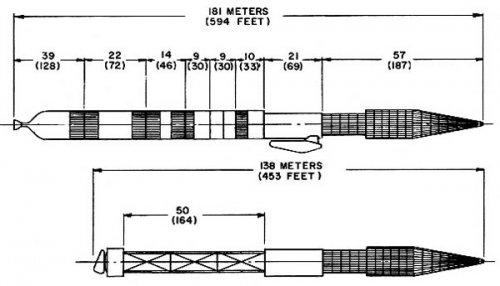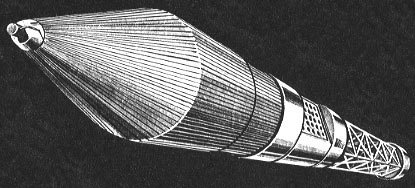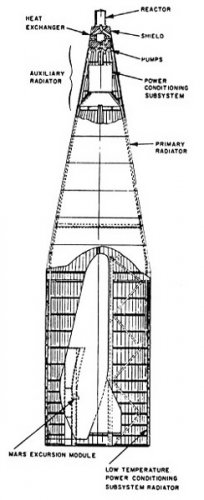- Joined
- 13 August 2007
- Messages
- 8,465
- Reaction score
- 11,073
better know as
Mission Engineering Study of Electrically Propelled Manned Planetary Vehicles
GE began the study for MSFC in July 1966.
they proposed to uses both nuclear-thermal and nuclear-electric propulsion.
Nuclear ionengine give mission flexibility also for unfavorable opportunities
and reduce mission duration 800-1000 day to 450 day !
the GE Mars spaceship is build of 12 Modules
1. Powerplant module (36.3 tons, 56,99 meter (187 feet) long)
with 3.6 tons nuclear fission reactor (3MW), 13,4 tons radiation Shadow shield
and 2 stage cooling radiator with sodium potassium loop.
Launch together Mars Excursion Module (MEM)
2. Electric Propulsion Module (65,5 tons 21 meter (69 feet) long 10 meter (33 feet) ø)
has array of 126 electron bombardment thrusters mounted in six rows of 21 units each (15 are reserve)
thrusters or array is 21 meter (69 feet) long and 3,2 meter (10.5 feet) wide
trust of array is only 7,71 kg (17 pounds ) trust but it works for months
Fourteen 1,5 meter (5 feet) ø tanks inside the module with a total of 45.1 tons
of dense cesium propellant for the thrusters. the cesium is solid frozen during launch.
3. Mars Excursion Module is a lifting body like (or is?) the Philco D9-I MEM
17,67 meter (58 feet) long, 8,6 meter (28.5 feet) wide and 5,79 meter (19 feet) deep
4 men crew for 30 day on Mars.
the MEM is dock on Electric Propulsion Module during flight to Mars
4. Expansion boom (49,98 meter (164 feet) unfolded)
After Mars departure some Module are separate changing the center of gravity of the space ship
for balance the ship for artificial gravity by rotation,
Expansion boom is unfolded from Electric Propulsion Module
5. Mission Module (33,3 tons - 6 meter (20 feet) long, 10 meter(33 feet) ø )
1690 cubic feet (515 cubic meter?) living space for 8 men crew.
during flight they have artificial gravity by rotation of spacecraft.
the 2 deck MM include a radiation shelter. labs, "health room", bedrooms, 2 spacecraft control center
6. Earth Entry Module is a Lifting body
9,5 Tons. 8,99 meter (29.5 feet) long 5,36 meter (17.6 feet) wide and 3,99 meter (13.1 feet) deep
during flight the EEM is store in adapter between MM and the MDS
7. Mars Departure Stage (8,99 meter (29.5 feet) long, 10 meter(33 feet) ø )
24 tons LOX/LH2 fuel and 2 engine with 6,8 tons (15000 pound) trust each
8. Mars Arrival Stage (8,99 meter (29.5 feet) long, 10 meter(33 feet) ø )
the stage weighs 61.9 tons. 2 engine with 6,8 tons (15000 pound) trust each
10.Earth Departure propellant Module 1
14 meter (46 feet) long, 10 meter(33 feet) ø. 72,6 tons of Lh2 and 1,5 tons of meteoroid protection panels
11.Earth Departure propellant Module 2
12,8 meter (72 feet) long, 10 meter(33 feet) ø. 127 tons of Lh2 and 2,4 tons of meteoroid protection panels
12.Earth Departure propulsion module
39 meter (128 feet) long, 10 meter(33 feet) ø. 160 tons (19,4 tons NERVA II engine, 120 tons of Lh2 and
3,75 tons of meteoroid protection panels )
the complet Earth Departure propulsion system weight 325 tons and is 74,9 meter (246 feet) long
the meteoroid protection panels of three modules are ejected before orbital launch
the GE Mars ship is assembly during 32 day in 482 km orbit, before launch to mars,
by 5 "improved" Saturn V with 160 tons payload
Launch 1 (T-32 days) Powerplant module & MEM
Launch 2 (T-27 days) Electric Propulsion Module+EB+MM+EEM with 8 men crew for assembly in orbit.
the crew move MEM out Powerplant module and dock sideway on Electric Propulsion Module which dock with rest.
Launch 3 (T-21 days) Mars departure stage, Mars arrival stage and first nuclear propellant module.
Launch 4 (T-12 days) the Mars mission crew in an emergency reentry vehicle and the second nuclear propellant module. Total weight is 152.1 tons.
Launch 5 (T-4 days) the Earth Departure propulsion module docks complets the Marsship
the assembly crew left the Mars ship with emergency reentry vehicle
the mission crew goes in radiation shelter and start up the Reactor for test
more on the mission later
source:
Romance to Reality homepage (offline)
now reborn as Altair VI http://altairvi.blogspot.com/
P.S.
strange on Altair IV and Astronautix
were article on GE Marsship but they disappeared...
Mission Engineering Study of Electrically Propelled Manned Planetary Vehicles
GE began the study for MSFC in July 1966.
they proposed to uses both nuclear-thermal and nuclear-electric propulsion.
Nuclear ionengine give mission flexibility also for unfavorable opportunities
and reduce mission duration 800-1000 day to 450 day !
the GE Mars spaceship is build of 12 Modules
1. Powerplant module (36.3 tons, 56,99 meter (187 feet) long)
with 3.6 tons nuclear fission reactor (3MW), 13,4 tons radiation Shadow shield
and 2 stage cooling radiator with sodium potassium loop.
Launch together Mars Excursion Module (MEM)
2. Electric Propulsion Module (65,5 tons 21 meter (69 feet) long 10 meter (33 feet) ø)
has array of 126 electron bombardment thrusters mounted in six rows of 21 units each (15 are reserve)
thrusters or array is 21 meter (69 feet) long and 3,2 meter (10.5 feet) wide
trust of array is only 7,71 kg (17 pounds ) trust but it works for months
Fourteen 1,5 meter (5 feet) ø tanks inside the module with a total of 45.1 tons
of dense cesium propellant for the thrusters. the cesium is solid frozen during launch.
3. Mars Excursion Module is a lifting body like (or is?) the Philco D9-I MEM
17,67 meter (58 feet) long, 8,6 meter (28.5 feet) wide and 5,79 meter (19 feet) deep
4 men crew for 30 day on Mars.
the MEM is dock on Electric Propulsion Module during flight to Mars
4. Expansion boom (49,98 meter (164 feet) unfolded)
After Mars departure some Module are separate changing the center of gravity of the space ship
for balance the ship for artificial gravity by rotation,
Expansion boom is unfolded from Electric Propulsion Module
5. Mission Module (33,3 tons - 6 meter (20 feet) long, 10 meter(33 feet) ø )
1690 cubic feet (515 cubic meter?) living space for 8 men crew.
during flight they have artificial gravity by rotation of spacecraft.
the 2 deck MM include a radiation shelter. labs, "health room", bedrooms, 2 spacecraft control center
6. Earth Entry Module is a Lifting body
9,5 Tons. 8,99 meter (29.5 feet) long 5,36 meter (17.6 feet) wide and 3,99 meter (13.1 feet) deep
during flight the EEM is store in adapter between MM and the MDS
7. Mars Departure Stage (8,99 meter (29.5 feet) long, 10 meter(33 feet) ø )
24 tons LOX/LH2 fuel and 2 engine with 6,8 tons (15000 pound) trust each
8. Mars Arrival Stage (8,99 meter (29.5 feet) long, 10 meter(33 feet) ø )
the stage weighs 61.9 tons. 2 engine with 6,8 tons (15000 pound) trust each
10.Earth Departure propellant Module 1
14 meter (46 feet) long, 10 meter(33 feet) ø. 72,6 tons of Lh2 and 1,5 tons of meteoroid protection panels
11.Earth Departure propellant Module 2
12,8 meter (72 feet) long, 10 meter(33 feet) ø. 127 tons of Lh2 and 2,4 tons of meteoroid protection panels
12.Earth Departure propulsion module
39 meter (128 feet) long, 10 meter(33 feet) ø. 160 tons (19,4 tons NERVA II engine, 120 tons of Lh2 and
3,75 tons of meteoroid protection panels )
the complet Earth Departure propulsion system weight 325 tons and is 74,9 meter (246 feet) long
the meteoroid protection panels of three modules are ejected before orbital launch
the GE Mars ship is assembly during 32 day in 482 km orbit, before launch to mars,
by 5 "improved" Saturn V with 160 tons payload
Launch 1 (T-32 days) Powerplant module & MEM
Launch 2 (T-27 days) Electric Propulsion Module+EB+MM+EEM with 8 men crew for assembly in orbit.
the crew move MEM out Powerplant module and dock sideway on Electric Propulsion Module which dock with rest.
Launch 3 (T-21 days) Mars departure stage, Mars arrival stage and first nuclear propellant module.
Launch 4 (T-12 days) the Mars mission crew in an emergency reentry vehicle and the second nuclear propellant module. Total weight is 152.1 tons.
Launch 5 (T-4 days) the Earth Departure propulsion module docks complets the Marsship
the assembly crew left the Mars ship with emergency reentry vehicle
the mission crew goes in radiation shelter and start up the Reactor for test
more on the mission later
source:
Romance to Reality homepage (offline)
now reborn as Altair VI http://altairvi.blogspot.com/
P.S.
strange on Altair IV and Astronautix
were article on GE Marsship but they disappeared...



